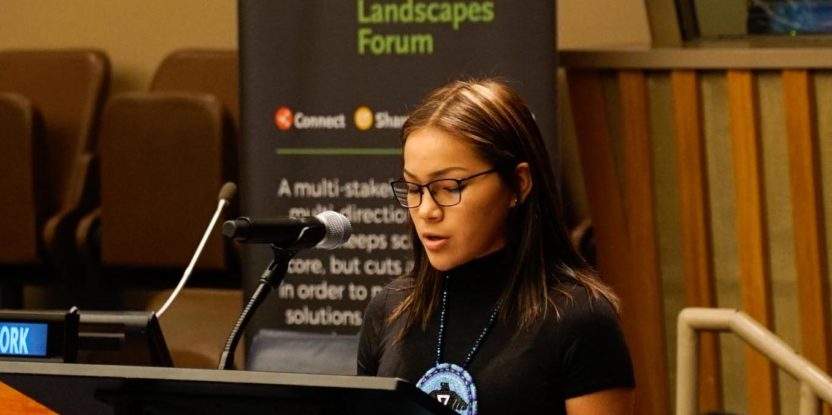
Autumn Peltier has taken the weight of the world’s water on her shoulders. As Chief Water Commissioner for the Anishnawbek First Nation in Canada, she’s at once an advocate for clean water security and Indigenous rights. Peltier is 15 years old.
“Flowing within us is original water, lifeblood of Mother Earth that sustains us, as we come from this land,” Peltier said in an address to hundreds of people at the United Nations in New York on Saturday. “Mother Earth’s power is in the lifeblood of mother earth, which is our waters. Mother Earth has the power to destroy us all, and if we keep harming her, one day she may decide to destroy everything,” she said.
Peltier’s speech opened the Global Landscapes Forum (GLF) on 28 September, a bookend to Climate Week and the U.N. climate summit fueled by youth-led climate strikes worldwide, excoriating remarks from 16-year-old Greta Thunberg, and delegates marking the 2020s as the “climate decade.” Putting forward an antidote to these outcries, the forum focused on a proven solution to slowing global warming and combatting climate change: restoration of the Earth’s landscapes.
In March, the U.N. General Assembly adopted the U.N. Decade on Ecosystem Restoration, devoting 2021-2030 to building research, traditional knowledge, finance, activism, consumer markets and public awareness around the economic, social and environmental benefits of restoring degraded landscapes. According to the Global Partnership on Forest and Landscape Restoration (GPFLR), there are some 2 billion hectares of degraded landscapes – a footprint the size of South America – which negatively impacts the lives of at least 3.2 billion people and costs a 10 percent loss of global Gross Domestic Product.
Swathes of solutions
To inform the upcoming decade on ecosystem restoration, the GLF event focused on the current state of the world’s various ecosystems, including forests, agricultural landscapes, mountains, drylands and rangelands, peatlands and wetlands, and oceans and coastal areas, floating ideas for restoring them.
During a presentation, Center for International Forestry Research (CIFOR) principal scientist Daniel Murdiyarso pointed out the immense potential of “blue carbon” ecosystems – seagrass, saltmarshes and mangroves – which together contain around 20 to 25 billion tons of carbon and sequester it at 20 times the rate of tropical forests.
“We need to dive deeper to look at this very important ecosystem if we’re talking about protecting the climate,” he said. “Lots of countries have opportunities to enhance their NDCs (nationally-determined contributions to emissions reduction) through blue carbon,” he added, but the majority make no mention of it in their current NDC plans.
Scientist Himlal Baral, also of CIFOR, addressed GLF about growing global demand for biofuel and the opportunity this presents to restore degraded landscapes by planting tree crops such as nyamplung (Calophyllum inophyllum), which has oily seeds that are a useful resource for bioenergy. Because only the seeds are harvested, the tree remains in the landscapes and provides multiple values, he said. Doing so “will strengthen economic incentives to the private sector and community groups to undertake restoration efforts,” Baral added.
A practice known as regenerative farming, which aims to incentivize farmers to plant in a sustainable manner, accounting for soil health, biodiversity and water in food production was discussed by Chris Newman, co-founder of permaculture-focused Sylvanaqua Farms.
More support from private finance is crucial for fair pay for farmers and incentivizing future generations to continue learning how to farm, as well as incorporation of Indigenous knowledge into farming practices.
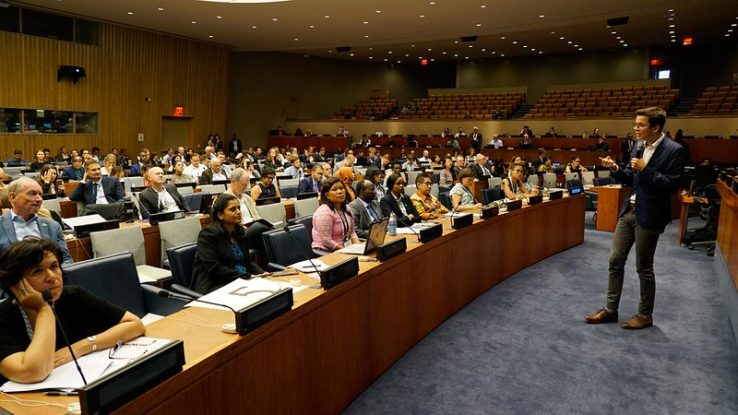
Felix Finkbeiner, founder, Plant-for-the-Planet speaks at Global Landscapes Forum, New York City 2019. Photo by GLF/Justin Davey
Felix Finkbeiner of Plant-for-the-Planet used the forum as an opportunity to launch a new phone app, weplant.app, which aims to mobilize people and organizations to plant trees. Those who “don’t want to get dirt under their fingernails” can use the app to donate money to support others’ planting, said Finkbeiner. The app harnesses the power of positive peer pressure to get friends, colleagues and students competing to plant the most trees.
Several speakers acknowledged that embracing complexity and diverse solutions would be crucial for achieving the aims of the U.N. Decade on Ecosystem Restoration. However, it is also important to collaborate at the global level and set “audacious goals”, said Dennis Garrity, who chairs the board of the Global EverGreening Alliance.
The Alliance launched its global Green Up to Cool Down campaign earlier in the week. It aims to “further accelerate the scaling-up processes that are already underway in order to achieve the drawing-down of 20 million tons of carbon dioxide from the atmosphere every year by the year 2050, using nature-based solutions,” Garrity said.
A race with nature
Nature-based solutions were a hot topic across almost all of the forum’s proposed interventions to tackle global warming. The term has been gaining airtime in international climate discussions and was a focus of the U.N. Climate summit and Climate Week. “We’re in a race against time, but we cannot be in a race against nature,” said Tony Simons, director general of World Agroforestry (ICRAF). “It must be a race with nature.”
Equally, restoration processes must not ignore human needs and dynamics, said World Agroforestry social scientist Susan Chomba. “It’s not just about planting trees; it’s about people,” she said. Governance issues are critical, and involving rural women is a must: “We need to bring them to the table and ensure that they get benefits and we’re not just adding another burden onto them.”
The role of Indigenous peoples, whose customary lands are home to 80 percent of the world’s biodiversity, was positioned as central to the U.N. Decade on Ecosystem Restoration as well as to environmental and sustainability efforts writ large through amplifying traditional knowledge on restoration methods that work.
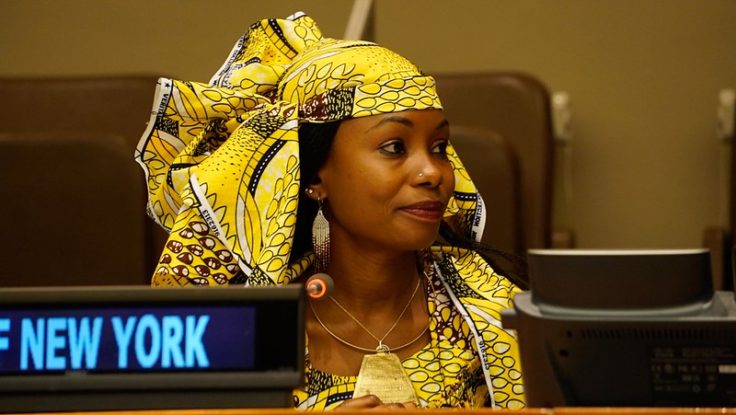
Hindou Oumarou Ibrahim, coordinator, Indigenous Women and Peoples Association of Chad, Indigenous Peoples of Africa Coordinating Committee, speaks at GLF. GLF/Justin Davey
Hindou Oumarou Ibrahim, coordinator of the Indigenous Women and Peoples Association of Chad, where two-thirds of the land is degraded due to climate change, advancement of the desert and loss of biodiversity, used her grandmother’s experience as an example: “She does not have a Ph.D. in land restoration, but is now being recognized by the Intergovernmental Panel on Climate Change because she is an expert on her land. So why can’t we move from saying ‘we need to be experts on this’ and go to those who have already been restoring for centuries, because those Indigenous peoples who don’t have Ph.D. know better how to sustainably restore their land?”
Funding a future
Not unexpectedly, a pressing question at the forum was: who will pay for the restoration we need? Estimates of the cost to restore a 350 million hectare portion of the world’s degraded territory tally in at approximately $800 billion, according to Inger Andersen, executive director of the U.N. Environment Programme.
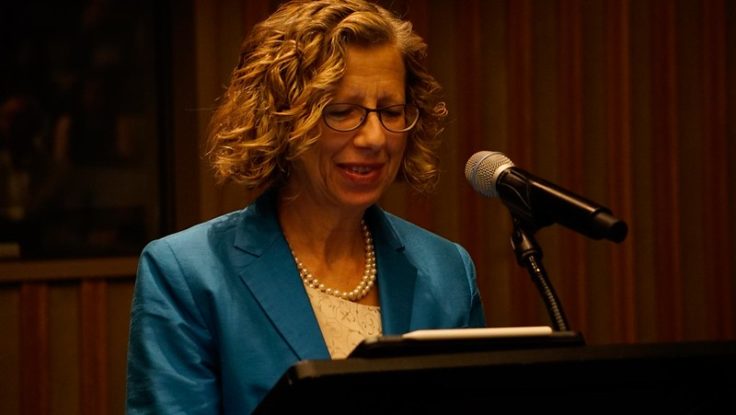
Inger Andersen, Executive Director, UN Environment Programme, speaks at GLF. GLF/Justin Davey
Andersen pointed out that the amount equates to only two years’ worth of fossil fuel subsidies. What’s more, restoring the territory could bring returns of $9 trillion. Quibbling about upfront costs seems somewhat petty when the challenges we face are put in context, said Anderson, adding that, “this Decade is about our very survival.”
Likewise, Peltier also put things simply: “We can’t eat money and we can’t drink oil,” she said.
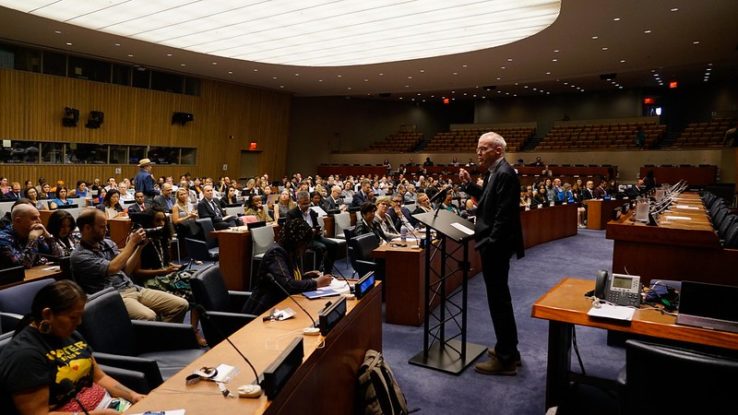
Bill McKibben, Co-founder 350.org, speaks at GLF. GLF/Justin Davey
Bill McKibben, founder of 350.org and bestselling author, turned Peltier’s work for water into a broader metaphor. “We need to be a downpour,” he said. “We need to be a human flood in this next decade, to wash away much of old world and make room for what comes next.”
We want you to share Forests News content, which is licensed under Creative Commons Attribution-NonCommercial-ShareAlike 4.0 International (CC BY-NC-SA 4.0). This means you are free to redistribute our material for non-commercial purposes. All we ask is that you give Forests News appropriate credit and link to the original Forests News content, indicate if changes were made, and distribute your contributions under the same Creative Commons license. You must notify Forests News if you repost, reprint or reuse our materials by contacting forestsnews@cifor-icraf.org.
Further reading
Video: Autumn Peltier speech at Restore the Earth Global Landscapes Forum New York
See what happened at GLF New York in pictures
Climate leaders to map out U.N. Decade on Ecosystem Restoration at GLF New York
GLF New York: U.N. climate, environment goals to gel under U.N. Decade on Ecosystem Restoration
Indigenous teen activist Autumn Peltier to advocate for water rights at GLF New York
Afro-roots musician Rocky Dawuni to detail youth, tree projects at GLF New York
Plant-for-the-Planet to launch app at Global Landscapes Forum in New York
Street artists paint massive mural in lead up to U.N. Climate Week
Timeline: Road to U.N. Decade on Ecosystem Restoration (2021-2030)